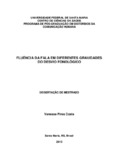| dc.creator | Costa, Vanessa Pires | |
| dc.date.accessioned | 2014-03-24 | |
| dc.date.available | 2014-03-24 | |
| dc.date.issued | 2013-02-28 | |
| dc.identifier.citation | COSTA, Vanessa Pires. Speech fluency in different severity degrees of speech disorder. 2013. 95 f. Dissertação (Mestrado em Fonoaudiologia) - Universidade Federal de Santa Maria, Santa Maria, 2013. | por |
| dc.identifier.uri | http://repositorio.ufsm.br/handle/1/6548 | |
| dc.description.abstract | This dissertation is structured in the alternative model according to what has been proposed by MDT (Structure and Presentation of Papers, Dissertations and Theses) UFSM. It is composed of an introduction followed by two scientific articles and, afterwards a discussion integrating the article results is presented. At the end, the final considerations are presented concluding the dissertation. The purpose of this research is to evaluate the speech fluency in speech disordered children, in different severity degrees of the deviation, as well as analyzing a possible relationship between fluency and the phonological system of these children. That is the focus of this research because one believes that the fluency in speech disordered children can be changed as an attenuation of certain speech difficulties. However, there aren t researches relating fluency and the speech disorder severity. The relationship between the disfluency and the phonological system of children is another important question that has been observed in some research results and in the speech pathologist s practice. One believes that speech disordered children present disruptions when faced with the non-acquired sound in their speech, trying to improve its intelligibility. That topic is discussed in the second article of this dissertation. One observed increase of disfluencies according to the severity degree decrease of speech disorder. This probably occurs because in the milder severe degrees, children present more moments of hesitation, trying to approximate their pronunciation to the pattern. On the other hand, children with severe disorder possibly do not present awareness of their own disorder | eng |
| dc.format | application/pdf | por |
| dc.language | por | por |
| dc.publisher | Universidade Federal de Santa Maria | por |
| dc.rights | Acesso Aberto | por |
| dc.subject | Criança | por |
| dc.subject | Fonoaudiologia | por |
| dc.subject | Linguagem infantil | por |
| dc.subject | Fala | por |
| dc.subject | Distúrbios da fala | por |
| dc.subject | Child | eng |
| dc.subject | Speech | eng |
| dc.subject | Language and hearing sciences | eng |
| dc.subject | Child language | eng |
| dc.subject | Speech disorders | eng |
| dc.title | Fluência da fala em diferentes gravidades do desvio fonológico | por |
| dc.title.alternative | Speech fluency in different severity degrees of speech disorder | eng |
| dc.type | Dissertação | por |
| dc.description.resumo | Esta dissertação está estruturada no modelo alternativo de acordo com o proposto pela MDT (Estrutura e Apresentação de Monografias, Dissertações e Teses) da UFSM, sendo composta por uma introdução seguida de dois artigos científicos, e posteriormente é apresentada uma discussão integrando os resultados dos artigos. Ao término, são apresentadas as considerações finais concluindo a dissertação. O objetivo do presente trabalho é avaliar a fluência da fala em crianças com desvio fonológico, em diferentes gravidades do desvio, assim como analisar uma possível relação entre fluência e o sistema fonológico dessas crianças. Acredita-se que a fluência em crianças com desvio fonológico possa estar alterada como forma de atenuação de certas dificuldades na fala, porém ainda não há estudos relacionando fluência e a gravidade do desvio fonológico. Outra questão importante que tem sido observada nos resultados de algumas pesquisas, assim como na clínica fonoaudiológica, é a relação entre as disfluências e o sistema fonológico das crianças. Acredita-se que crianças com desvio fonológico apresentem rupturas diante do fonema que ainda não está estabilizado em sua fala, na tentativa de melhorar a inteligibilidade, sendo que esse tema é discutido no segundo artigo desta dissertação. Como resultado foi encontrado que em algumas variáveis há um aumento das disfluências conforme a diminuição da gravidade do desvio fonológico, provavelmente porque nos desvios mais leves as crianças apresentam maiores momentos de hesitação na tentativa de aproximar a sua pronúncia do padrão. Já as crianças com desvio grave possivelmente não apresentam essa consciência do próprio desvio. | por |
| dc.contributor.advisor1 | Mota, Helena Bolli | |
| dc.contributor.advisor1Lattes | http://lattes.cnpq.br/3717425754253849 | por |
| dc.contributor.referee1 | Keske-soares, Marcia | |
| dc.contributor.referee1Lattes | http://lattes.cnpq.br/2993790524055307 | por |
| dc.contributor.referee2 | Donicht, Gabriele | |
| dc.contributor.referee2Lattes | http://lattes.cnpq.br/8926016516397508 | por |
| dc.creator.Lattes | http://lattes.cnpq.br/1536123410010951 | por |
| dc.publisher.country | BR | por |
| dc.publisher.department | Fonoaudiologia | por |
| dc.publisher.initials | UFSM | por |
| dc.publisher.program | Programa de Pós-Graduação em Distúrbios da Comunicação Humana | por |
| dc.subject.cnpq | CNPQ::CIENCIAS DA SAUDE::FONOAUDIOLOGIA | por |


